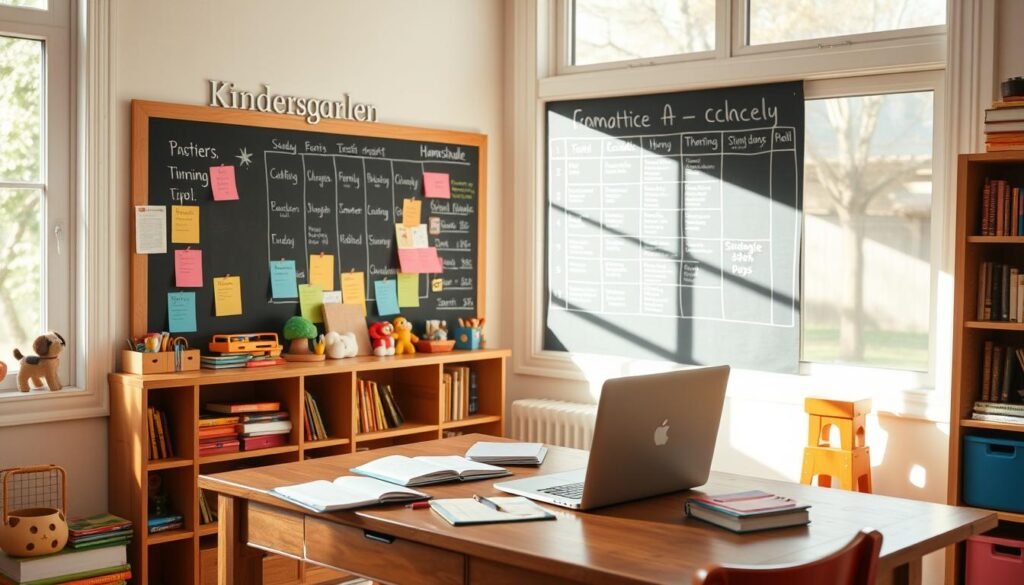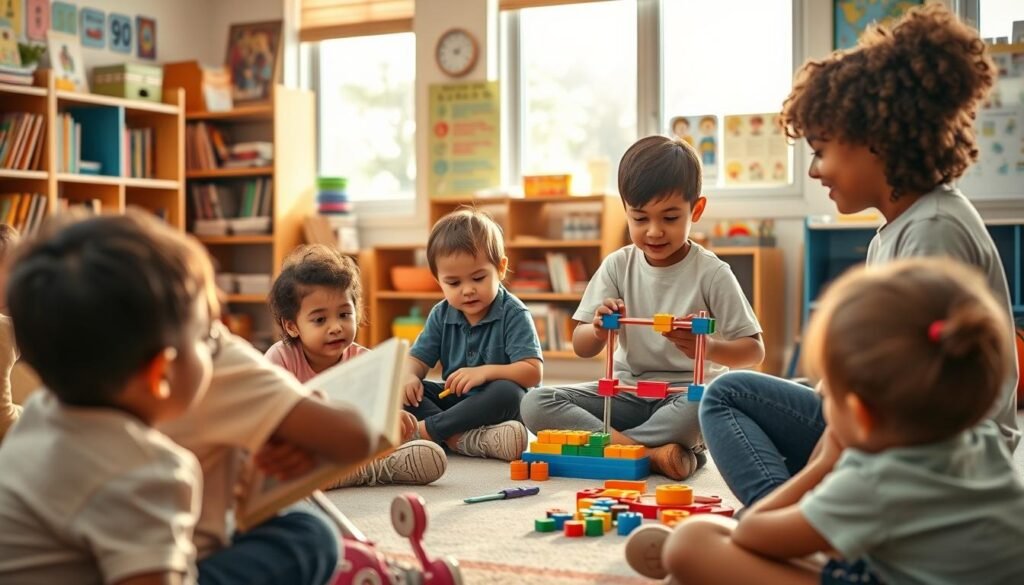
Starting a kindergarten homeschool journey makes learning an exciting adventure. It opens a world of personalized learning that sparks your child’s curiosity and love for knowledge.
Creating the perfect kindergarten homeschool schedule needs careful planning and flexibility. Studies show kids learn best through fun, play-based activities that fit their interests and learning ways.
Begin your homeschool day around 9:00 AM for the best results. A well-planned homeschool routine boosts learning while making it fun. You’ll turn learning into an exciting journey, not a task.
Table of Contents
Understanding the Foundations of Kindergarten Homeschooling
Starting your kindergartener’s homeschooling journey is both thrilling and daunting. Early childhood education has changed a lot, with more families choosing homeschooling. In the 2020-2021 school year, about 3.7 million students were homeschooled in the U.S. This shows a big change in how we learn.
Benefits of Home Education at Early Age
Creating a personalized learning space for your child changes what kindergarten readiness means. Homeschooling offers benefits that schools can’t:
- Personalized attention that fits your child’s learning style
- A curriculum that changes based on your child’s interests
- A safe and cozy place to learn
- Deeper family bonds from learning together
Studies show homeschooled kids often do better on tests than public school kids. They score 15 to 30 percentile points higher. This shows homeschooling can be very effective.
Legal Requirements and State Regulations
Before starting your homeschool, you need to know your state’s rules. Each state has its own rules, from how to notify them to keeping records. Following these rules is important for a smooth homeschooling experience.
Setting Educational Goals for Your Child
Creating a homeschool plan for kindergarten means setting clear goals. Think about a mix of learning and play. The National Home Education Research Institute found 83% of homeschool parents are happy with their kids’ education. This shows homeschooling can be very successful.
Remember, your homeschooling journey is unique. Be flexible and enjoy learning with your child.
Creating Your Daily Kindergarten Homeschool Schedule
Creating a good homeschool routine needs careful planning and being flexible. Your kindergarten homeschool schedule should mix structured learning with fun exploration. It’s important to find a rhythm that fits your child’s energy and learning style.
A successful homeschool planning approach includes several key points:
- Short, engaging learning sessions
- Regular breaks to keep things interesting
- Hands-on activities
- Flexibility for unexpected learning moments
Kindergarteners usually have focused time blocks that don’t last more than an hour. Your homeschool routine might look like this:
- Reading/Phonics: 15 minutes
- Mathematics: 15 minutes
- Exploratory Play: 1-2 hours
- Creative Activities: 30 minutes
Think about your child’s attention span and energy when planning your homeschool. Some kids do better in the morning, while others need a snack or some exercise first. Watch and adjust your schedule to fit your kindergartener’s unique learning pace.
Remember: The most effective homeschool routine is one that keeps learning enjoyable and engaging.
Essential Components of Morning Routine
Creating a good daily schedule for kindergarten homeschooling starts with a morning routine. The first hours of the day are key for learning. They can greatly affect your child’s educational activities and how engaged they are.
Your morning routine should be both structured and flexible. It should create a learning-friendly environment that’s exciting. A well-planned start helps kids smoothly move into learning while keeping their curiosity and enthusiasm alive.
Breakfast and Morning Preparation
Nutrition is important for your child’s learning. A balanced breakfast gives them the energy for learning. Let your kindergartener help with simple meal tasks. This develops practical skills and gets them excited for the day.
- Prepare a nutritious breakfast together
- Allow child to help set the table
- Discuss the day’s learning goals
Physical Activities to Start the Day
Physical movement is key in your daily schedule. Short, fun exercises help kids release energy and focus for learning.
- Morning stretching
- Dance to educational music
- Simple yoga poses for kids
Setting the Learning Environment
Make a welcoming learning space that sparks curiosity and keeps distractions away. Your learning area should be clean, organized, and filled with age-appropriate educational materials.
A well-prepared environment is the foundation of successful home education.
By adding these morning routine parts, you’ll create a positive start for your kindergarten homeschool. Your child will be ready to learn and explore each day.
Structuring Core Academic Blocks

Creating effective core academic blocks is key for your kindergarten homeschool resources. Your homeschool schedule should mix structured learning with fun activities. This keeps young learners excited about learning.
Kindergarten learning focuses on five main areas:
- Mathematics: Basic counting, shapes, and simple problems
- Language Arts: Reading and writing basics
- Science: Simple experiments and nature
- Art: Creativity and fine motor skills
- Physical Education: Movement and gross motor skills
When planning your kindergarten homeschool schedule, consider these tips:
- Learning sessions should be short (8-10 minutes)
- Switch between sitting and moving activities
- Hands-on activities keep learners engaged
- Play-based learning is effective
A good daily plan might include 30-60 minutes of learning, split into short sessions. This meets young children’s needs while covering all subjects.
Flexibility is crucial in homeschooling. Your schedule should change to fit your child’s learning style, interests, and energy levels.
Balancing Academic Learning with Play-Based Activities
Play is a powerful tool in your kindergarten at-home learning journey. It makes learning fun and engaging. Research shows that play-based learning boosts children’s academic outcomes and development.
Young learners do best when learning is fun and full of discovery. The right mix of structured learning and play can make homeschooling exciting.
Importance of Unstructured Play
Unstructured play is key for your child’s growth. It helps them:
- Develop creativity and problem-solving skills
- Learn social interaction naturally
- Build emotional intelligence
- Explore their imagination
“Play is often talked about as if it were a relief from serious learning. But for children, play is serious learning.” – Mr. Rogers
Incorporating Educational Games
Turn learning into an adventure with fun games. Some great at-home learning games are:
- Memory matching games for cognitive skills
- Counting board games for math concepts
- Storytelling dice for language development
- Puzzle-solving challenges
Outdoor Learning Opportunities
Nature is a great classroom for kindergarten. Outdoor learning can include:
- Scavenger hunts to teach observation skills
- Gardening to understand plant life cycles
- Weather tracking and measurement
- Animal and insect identification
The goal is to make learning feel like play. This keeps your child motivated and excited to learn through fun, interactive experiences.
Managing Time Effectively in Your Homeschool Day
Creating a good homeschool plan makes your day run smoothly. Kindergarten doesn’t need long study times. Studies say young kids need only 30-60 minutes of learning each day.
Having a flexible schedule helps your child learn well and enjoy their childhood. Your homeschool plan should focus on:
- Short, fun learning sessions
- Enough time for play
- A routine that fits your child’s energy
Good homeschool time management means flexible learning times. Kindergarteners learn best in short, fun lessons. Aim for quality, not just how much you do, spread out through the day.
Efficiency in homeschooling means understanding that learning happens everywhere, not just during formal lessons.
Think about dividing your day into focused parts:
- Morning exploration (30-45 minutes)
- Reading time (30-60 minutes)
- Creative activities (20-30 minutes)
- Outdoor learning (45-60 minutes)
Your homeschool plan should be flexible, allowing for surprise learning moments. Remember, kindergarten is about sparking curiosity, not strict learning.
Incorporating Life Skills and Practical Learning
Turning everyday moments into learning is key in a good preschool curriculum. Your kindergarten homeschool journey can be full of exciting learning experiences. These experiences help grow curiosity and independence.
Adding real-world experiences to your lessons helps kids learn important skills. These skills go beyond just schoolwork. They build confidence and connect kids to the world.
Kitchen Science and Cooking Adventures
Cooking is a great way for young learners to learn. Simple recipes can teach many things:
- Measuring ingredients introduces basic math skills
- Following recipe steps develops sequential thinking
- Understanding ingredient transformations sparks scientific curiosity
Basic Household Management Skills
Get your child involved in simple household tasks. This builds responsibility and practical knowledge:
- Sorting laundry by color
- Setting the table
- Organizing personal belongings
Social Skills Development
Teaching social skills needs a plan. Board games, cooperative play, and structured interactions help kids learn important social skills.
| Social Skill | Learning Strategy |
|---|---|
| Turn-taking | Board games and group activities |
| Sharing | Collaborative play with toys like Legos |
| Emotional Understanding | Social stories and role-playing |
Learning is everywhere. By making learning part of daily life, you create a rich preschool curriculum. This prepares your child for future success in school and socially.
Adapting Your Schedule for Different Learning Styles

Every child learns in their own special way. This makes their early education journey unique. By recognizing and embracing these differences, you can make your teaching approach stand out.
It’s key to understand learning styles for a great homeschool environment. Studies show that 90% of parents value a personalized schedule for different learning needs.
- Visual Learners: Do well with charts, diagrams, and bright colors
- Auditory Learners: Like listening and talking
- Kinesthetic Learners: Learn best by doing and moving
Loop scheduling is a great strategy in early education. It lets you:
- Lessen scheduling stress
- Meet each child’s learning style
- Stop learning burnout
- Find new learning chances
By making your homeschool routine flexible for your child’s learning style, you’ll make learning fun and personal. Also, 50% of families change their homeschooling schedule to match their child’s progress. This shows how important being flexible is.
Planning for Social Interaction and Field Trips
Social interaction is key for kindergarten readiness. Your homeschool resources can include field trips and social activities. Kansas City has many chances for families to learn together, with over 20 families going on educational outings.
Think about different themes for field trips, like science, nature, and history. The Deanna Rose Farmstead is a great place to visit, offering free entry on weekdays after 2 p.m. It costs about $5 to $10 per child, with discounts for groups of 10 or more. Families on SNAP benefits might get free or cheaper entry to museums and educational spots.
Use online tools like SignUpGenius or private Facebook groups to plan with other homeschool families. The “Terrific Tuesdays” program shows how community can boost learning. Before going, check the venue’s website and set learning goals for your child to make the most of the trip.
Field trips can be a big part of your homeschool. Plan to go on trips every month during the school year and weekly in the summer. These outings help your child stay curious and connected, while also making learning fun and memorable.
